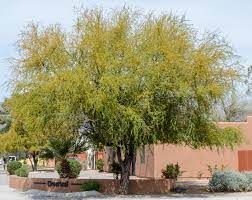Acacia

Great Roots from Container Grown Trees!
I had a couple Sweet Acacia (Acacia smallii?) trees that I grew from seed and planted in my yard. The cold weather this past winter killed two of the four trees to the ground! I was surprised that they reacted as poorly as they did to the cold temperatures (see below). Because of that, and their propensity to grow mistletoe, I decided to replace them with Ironwoods (Olneya tesoto) from Arid Zone Trees.
Here is some interesting info on Sweet Acacia trees Arid Zone Trees website.
TAXONOMY Plant taxonomy is the science of organizing plants into established categories and giving them names (a Latin binomial), based on their characteristics. Originally this tree was called Acacia farnesiana after the 17th century Roman Cardinal Odoardo Farnese. Since the late 1960’s plant taxonomists have been troubled by the wide variety of horticultural characteristics (flowering periods, cold hardiness etc.) exhibited by Sweet Acacias. In 1969 it was proposed that Sweet Acacias actually represented two different tree species. Acacia smallii was proposed as the name for all the Sweet Acacias occurring from California to western most Florida and Acacia farnesiana for those trees found in the balance of Florida and the Caribbean.
The horticulturalcharacteristic of greatest interest to landscape professionals in the desert southwest is cold hardiness. Experience over the last 10 to 15 years has shown that Acacia farnesiana is severely (sometime fatally) damaged by temperatures below 20 to 25 degrees F. In contrast Acacia smallii appears hardy to about 15 to 20 degrees F.and survives most central and southern Arizona and southern California winters injury free. While there are other physical (tree structure) and botanical distinctions between these two species the greater cold hardiness of Acacia smallii is of most interest to landscape professionals.
So, maybe what I grew were Acacia farnesiana! At least they seemed to react to freezing temps that way.
I grew these Sweet Acacia trees in root management containers (similar to, but a different style than Arid Zone Trees uses). These containers direct the seedling’s roots toward the bottom of the container and when they get there they encounter – air! Yes, the bottoms are open and they sit in a wire mesh box. When the roots hit the air, they stop growing and branch out. This gives them a super root structure that is ready to take off when planted. Just look at the roots on the tree below! It was about the size of a 36″ box tree in caliper, but I could barely pull the roots out with my F350 truck! No girdling roots here!
